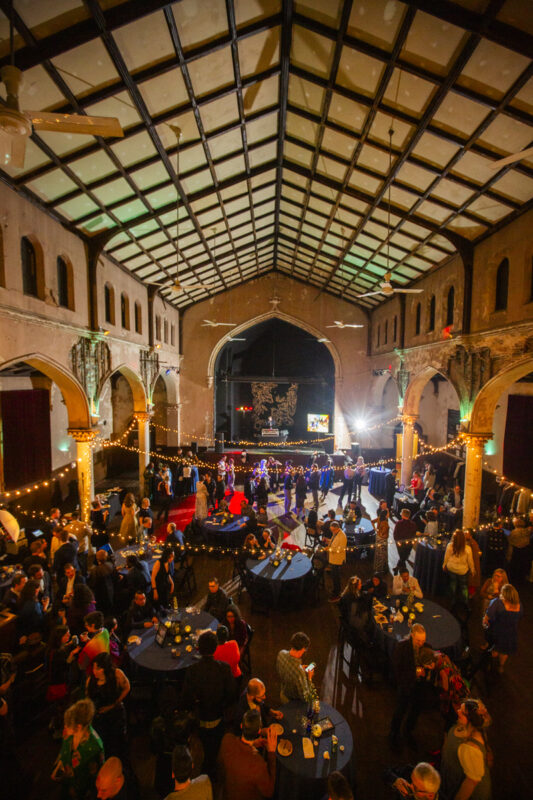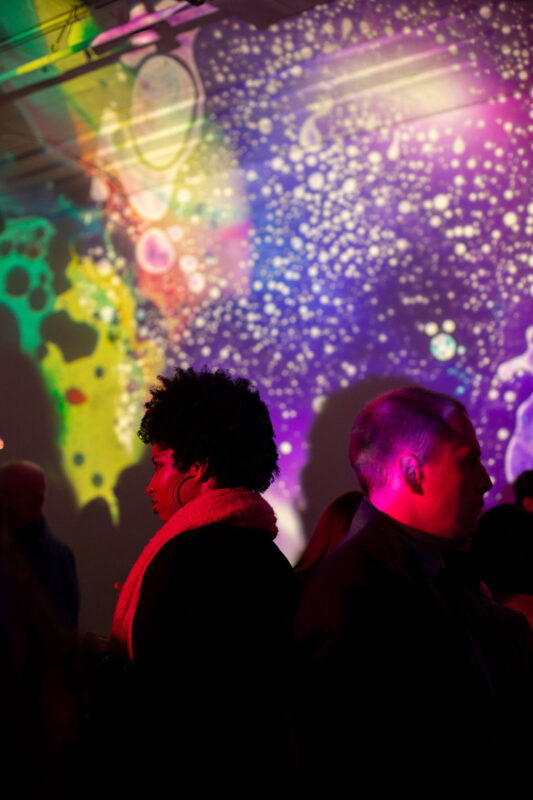I got my first glimpse of the Maryland Historical Society’s (MdHS) Fashion Archives last summer at a research presentation by summer interns working on the collection. The garments pulled for the event hinted at the exciting possibilities of the collection: a 1920s dress made by Niells of Baltimore alongside a robe de style from Paris of the same period; one of First Lady Frances Folsom Cleveland’s glamorous gowns made by Lottie Barton, a Baltimore dressmaker; a long livery coat and cape from 1888 worn by Tilghman Davis, who was enslaved by the Ridgely family at Hampton Mansion in Towson, and who continued to work for the family after emancipation. This small slice of a collection containing over 12,000 articles of clothing hints at its scope: garments that tell local stories, and those that are part of international ones. The collection ranges from uniforms to gowns. It isn’t made up of sample sizes and garments only worn on runways, and while many of the garments come from Maryland’s wealthier classes, there are plenty that tell everyday stories about fashion history and why we wear what we wear.
This is clearly the vision that Alexandra Deutsch, former Vice President of Collections and Interpretation at the Maryland Historical Society. (Allison Tolman has taken over at VP of Collections at MDHS.) Deutsch was the driving force behind the rediscovery of the museum’s incredible fashion collection, which had been left uncatalogued and in boxes for almost 30 years when she first arrived at the museum in 2008. As the museum prepares to open Spectrum of Fashion: Celebrating Maryland’s Style, its first large scale fashion exhibition, on October 5, I talked to Deutsch about her work with the Fashion Archive and her philosophy as a curator. Though Deutsch recently accepted a new post as Director of Museum Engagement at Winterthur Museum, Garden and Library, she has continued to contribute to this exhibition and the accompanying catalogue.

Alexandra Deutsch
Victoria Pass: I know that you started at the Maryland Historical Society in 2008 as Deputy Director of Special Projects and were quickly promoted to Chief Curator of the Museum. What brought you to the Maryland Historical Society? What about the museum’s mission speaks to your own interests as a historian and curator?
Alexandra Deutsch: I came to the Maryland Historical Society for the collection which is vast and nationally recognized. I was coming from a museum with a collection of about 3,000 objects and the thought of curating around 350,000 objects, dating from the 17th century to the present, was thrilling. I wanted to work with a collection that would take many lifetimes to learn so that there was no end of possibilities; that is exactly what MdHS offers.
Your recent exhibition, Woman of Two Worlds: Elizabeth Patterson Bonaparte and Her Quest for An Imperial Legacy, uses material culture—including fashion—to illuminate the complex life of Elizabeth Patterson Bonaparte and really brings her to life as more than just Napoleon’s sister-in-law. You use the objects in that exhibition to show how a woman of her class could use designed objects and fashion to construct her celebrity persona, and to live a life somewhat out of the bounds of what was conventional for a woman of her time. How does that exhibition and the book you wrote, A Woman of Two Worlds: Elizabeth Patterson Bonaparte, reflect your approach to curation in the context of a history museum?
The study of material culture is central to how I interpret objects. I am always trying to decode the stories of identity and time that objects represent. It is all about constructing context for why objects were made, purchased, used, etc. I was very fortunate to be the person who curated the exhibition about Elizabeth Patterson Bonaparte. The museum’s collections of over 600 objects associated with her and her family, paired with thousands of documents in her own hand and the hand of her son and grandsons, allowed me to understand the material culture of the American Bonapartes in a way that was extraordinary. Rarely do you ever have that much documentation for objects. I was able to construct stories that I never imagined discovering because the intersections of the objects with the documents was remarkably complete.

Fashion Archives at the Maryland Historical Society. Photo by author
You’ve described finding the Fashion Archives as a “collection in boxes” at the museum. Can you talk about the process of bringing this collection back to life after about 30 years of lying dormant?
In 2008 when I arrived at MdHS, I was astonished to see that the costume collection was not on view in any of the galleries. It was sitting in storage, hundreds and hundreds of boxes, many of them untouched since the 1970s and early 1980s when they were first put there. I then learned that the collection was not in the collections database, making it almost impossible to know exactly what costumes the museum owned. Thankfully, many of the garments were documented on hand-written index cards created in the 1970s; the cards provided detailed descriptions of the garments and, in some instances, a photograph. It was literally a “box by box” process of discovery that began in 2009. Starting in 2011, I knew enough about the collection to begin incorporating pieces into exhibitions. By 2016, a generous donor, Barbara Katz, offered to fund three summer internships that would focus on rehousing and cataloguing the costume collection. For 10 weeks each summer, interns spend seven hours a day working with the costume collection, making certain it is properly cared for in acid-free boxes, photographing it, and creating catalogue entries for each piece. Without that kind of painstaking attention to the collection, we would not know what was in the boxes!

Printed Cotton Dress with Wool Knit Sash, 1955, dress designed by Claire McCardell (1905-1958), fabric designed by Marc Chagall (1887-1985), worn by Natalie Mendeloff (1921-2015). Photo by author.
It seems like part of the importance of the Fashion Archives for you is the way that it connects to the public and helps to make the museum more relatable to visitors. I think of Fred Wilson’s groundbreaking Mining the Museum exhibition with the Contemporary Museum, at the MdHS in 1992, which challenged museums of all kinds to think about whose stories are being told and how. In many ways, museums continue to grapple with making themselves more inclusive and accessible to a broad public. In what ways do you think the Fashion Archives at the museum offers the opportunity to expand the kinds of narratives that are a part of the MdHS, and the ways those stories are told to visitors?
The costume collection, now known as the Fashion Archives, was built almost exclusively through gifts. The result is that it evolved organically as donations from the community came to the collection. Over the past decade of working with the costumes, we now see where there are gaps and stories we cannot represent with it. During my tenure at MdHS, our collecting mission has been to focus more on clothing and accessories that post-date 1950, clothing that represents economic and social diversity and examples of design that reflect important, more recent movements in fashion such as all-gender design. Inclusivity is guiding acquisitions for not only the costume collection, but all collections at MdHS. We have to build this collection as a whole with an eye to the future so that 50 or 100 years from now we can still tell the stories of all Marylanders.
You are a collector and wearer of vintage clothing. What drew you to vintage clothes? How do they relate to your own self-fashioning and ways of thinking about dress and personal style?
I have always loved everything old. In college, I was buying bits of vintage here and there. I had an amazing 1920s velvet cloak I used to wear, I bought Victorian nightgowns, and had a few 1950s cashmere sweaters, but I didn’t know wearing vintage was a “thing.” In 2009, I was invited to a “Mad Men” party and wanted to go as Betty Draper in full-on period clothing. It was the first time I seriously vintage-shopped and I was so lucky to meet Charlotte and Henry Bevers of Luna Blue Vintage, then in Hampden. They helped outfit me and, from that moment on, I was hooked. I now wear almost exclusively vintage. The quality of the clothing is so superior and it ensures that I will never be wearing the same thing as someone else. Clothing is one of the most powerful ways to express identity and I love that when I am wearing vintage, it communicates how much I love fashion, I love history, and I have my own point of view about clothing that isn’t influenced by trends.

Silk Chiffon Evening Dress, 2009, designed by Bishme Cromartie
The power of clothing to express identity is definitely what draws me to fashion history as a researcher, and I think it’s what hooks students too. When I brought my students to see the Fashion Archives they were really excited to have the opportunity not only to see the beautiful garments up close, but also to hear you and the other curators tell the stories of the people who wore them, how they acquired them, how they changed them over time, and where they wore them. Do you have any favorite discoveries in the collections? Stories that you are particularly excited to tell in the exhibition?
I have so many “favorite” discoveries, it is difficult to pick just a few. Every week, we find some treasure we did not know we had because the collection had never put in a database before now and was never comprehensively documented. One of my all-time favorite pieces in the collection is a pair of 18th century stays [a boned undergarment that shapes the torso] that were adapted and repaired so many times to conform to the changing silhouette of the 19th century. They were originally very expensive stays embroidered with a pattern which is more unusual, but, over time, I suspect the wearer’s financial circumstances changed or they were passed on to another wearer, and adapting them to the current fashion was the only option. I just know that those stays have many stories to tell, some of which we will never know.
One of the most thrilling things we found last summer was livery worn by Tilghman Davis who lived at Hampton Mansion in Towson. Davis was formerly enslaved by the Ridgely family, but, post-emancipation, chose to remain on the estate. I have to credit Norah Worthington, an instructor at Baltimore School for the Arts, with the discovery. Livery in American collections is rare and knowing the wearer is even more unusual. Another epic discovery in the collection was the lace gown and mantilla worn by Elizabeth Patterson Bonaparte and given to her by Jérome Bonaparte, youngest brother of the Emperor Napoleon. It was recorded over and over again in Elizabeth’s inventories, but we did not find it until years of meticulously going through Elizabeth’s vast collection of lace. First we found the gown and then we found the mantilla, both twisted up in balls that looked like bird’s nests. It then turned out that we had the original bill of lading for the shipment of gifts Jérome sent her after their separation and the lace gown was recorded on it! I have to credit the work I did with my curatorial volunteer Barbara Meger that led us to those discoveries. We both had tears in our eyes when we found the pieces.

Wool Livery Cape (.26) and Overcoat (.28), 1888, worn by Tom Brown (.26) and Tilghman Davis (.28)
That’s incredible! No doubt there are many more stories yet to be found in the archive. I think that one of the other exciting elements is the way the archive highlights Maryland’s fashion industry. While most people tend to think of the fashion industry being centered in Paris, London, Milan, or New York, the garments in the Fashion Archives show the incredible designers, drapers, seamstresses, and other makers working in Maryland. Do you have any favorite local designers that will be highlighted in the exhibition?
Everyone who works with this collection is obsessed with Claire McCardell and for good reason. Her designs are so remarkable and I can truly say there is not one of her designs I wouldn’t wear today. Last summer, our intern Nora Carleson, a PhD candidate at the University of Delaware, discovered examples of the work of Lottie Barton in our collection. Barton is an amazing story because, at the height of her work in the late 19th century, she maintained an atelier of 50 employees right in Baltimore. She was caught smuggling French fashions into the United States to avoid duties, as many American dressmakers did, and she produced garments comparable to anything that could be bought in Paris at that time. We are also highlighting current local designers—Ella Pritsker, Jody Davis, Bishme Cromartie, and Christian Siriano—in the exhibition. There is a strong commitment to representing Maryland designers today.
Claire McCardell, who you mentioned, is definitely a designer most of the fashion historians I know are obsessed with too! I think the fact that she was really thinking about what a modern woman who maybe worked outside the home—as she did—would want to wear feels very relevant to us now. It’s been a thrill for me to see her mid-century designs close up in your archive, since her techniques of draping and shaping garments were so innovative. Can you talk about what makes her such as significant figure in the Fashion Archives for people who may not have heard of her?
Claire McCardell was an innovator extraordinaire. She designed clothes she as a woman wanted to wear and that led her to creating designs that changed fashion forever. When I think of all of her innovations—ballet flats, industrial fittings for closures, the popover dress, the idea that having a fixed waist on a garment was impractical and that giving a woman a sash to place where she wanted it was more practical and flattering, on and on—I have to say that she was a genius. At the very moment Christian Dior’s New Look was hitting the runway and influencing much of fashion, McCardell was standing behind her own design and creating stylish, flattering fashion that allowed women to move, work, and have modern lives. In addition, the construction of her garments which seems so simple is, in fact, remarkably complex and ingenious. I am so glad she is getting the acknowledgement and attention she deserves as one of the most important designers of the 20th century.

Silk Faille Evening Dress, 1945-1949, Designed and worn by Claire McCardell (1905-1958)
What is your ambition for the Fashion Archives moving forward? It’s been about 10 years since you and the staff of the museum have started work on cataloguing and conserving the collection—where would you like the collection to be in another 10 years?
A decade from now, I hope that the Fashion Archives is widely known both nationally and internationally for the extraordinary collection it is. I hope it is a hub for scholars of fashion history and that it is regularly exhibited and celebrated as one of the greatest components of the Maryland Historical Society’s collection. I also hope that the collection continues to grow with new acquisitions that make it more inclusive and relevant. I believe it is very important to represent the fashions and fashion designers of today in this collection so that it will continue being an archive, representing Maryland’s style from the 18th century to the present. In my dream world, the entire collection would be photographed, catalogued, and housed in state-of-the-art storage within 10 years.
Spectrum of Fashion: Celebrating Maryland’s Style opens October 5. Tickets for the opening night gala, which includes a fashion show hosted by Maryland designer and Project Runway alum Christian Siriano, are now available.
All images courtesy of the Maryland Historical Society, except where otherwise noted.
Featured image (L-R): Wool Livery Cape (.26) and Overcoat (.28),1888, Worn by Tom Brown (.26) and Tilghman Davis (.28), Maryland Historical Society, Gift of John Ridgely, 1944.76.26 & .28.
Silk Faille Evening Dress, 1945-1949, Designed and worn by Claire McCardell (1905-1958), Maryland Historical Society, Gift of Robert McCardell, 1998.43.27.
Silk Satin and Silk Velvet Robe de Style, 1922-1925, likely made in France, Worn by Amelia Prescott Allison (1899-1989), Maryland Historical Society, Gift of Mrs. Campbell Lloyd Stirling, 1974.14.2.






